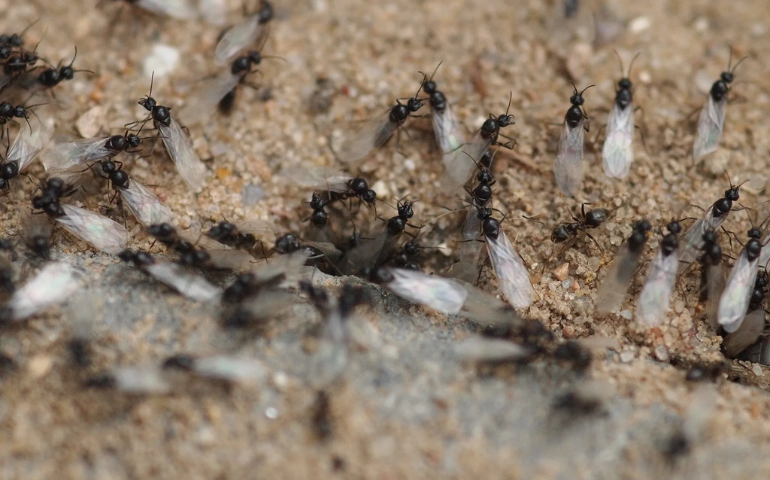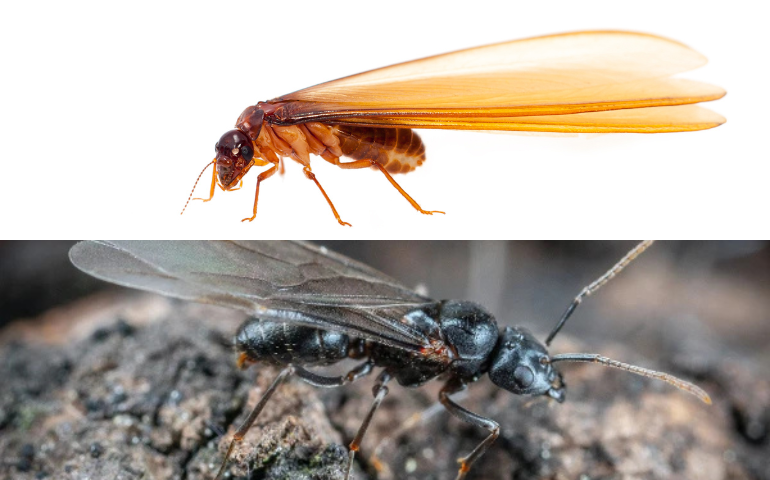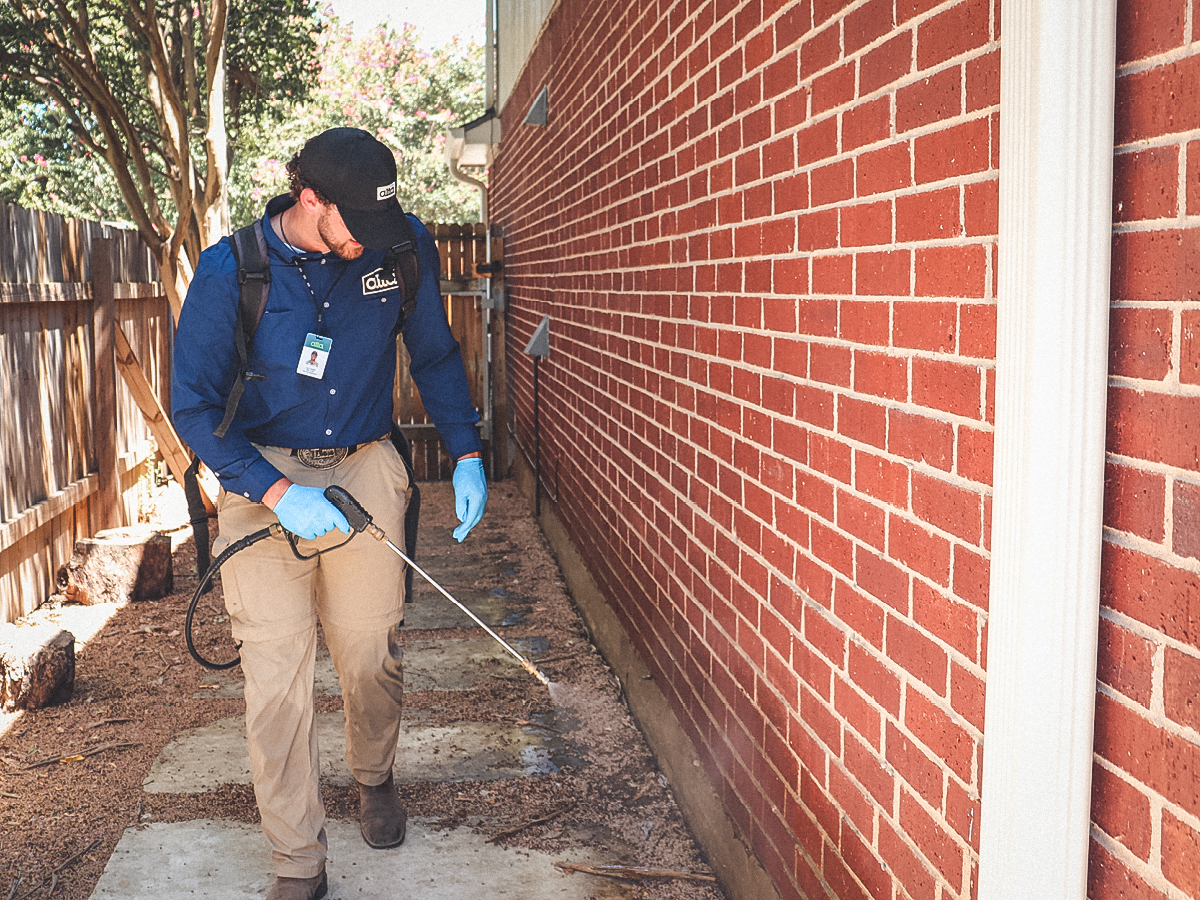Are you seeing flying ants in your home all the time? If you’ve noticed winged ants swarming around your windows, light fixtures, or suddenly in your kitchen, you’re not alone. You have come to the right place if you are trying to figure out its causes and prevention tips.
Flying ants are seasonal invaders and can quickly turn from a minor annoyance into a major headache, especially if they’re carpenter ants that could damage your home structure.
Let’s break down what you’re dealing with and what to do next.
What Are Flying Ants?

Flying ants aren’t a separate species—they’re reproductive ants (males and future queens) that develop wings during mating season. When conditions are right, these winged ants leave their colonies to mate and establish new colonies elsewhere. Unfortunately, “elsewhere” sometimes means inside your home.
Most ant species produce flying reproductives, so the winged ants you’re seeing could be:
Carpenter Ants
Carpenter ants are among the most concerning flying ants you might encounter. They’re typically larger (1/2 to 5/8 inch) with black or reddish-black bodies. Unlike termites, they don’t eat wood but excavate it to build nests, which can cause significant structural damage over time. If you’re seeing large black flying ants, especially near damaged or damp wood, carpenter ants might be your unwelcome guests.
Odorous House Ants
These common household pests emit a distinctive coconut-like smell when crushed. Their flying reproductives are smaller (about 1/8 inch) and dark brown to black. While they don’t cause structural damage, they can contaminate food and become a persistent nuisance, especially in kitchens and bathrooms where moisture is present.
Fire Ants
In southern regions, fire ant swarms can be particularly troublesome due to their painful stings. Their flying reproductives are reddish-brown with clear wings and can cause concern when they enter homes during seasonal mating flights.
Argentine Ants
These invasive pests form massive supercolonies and produce flying ants that can become a significant nuisance when they swarm. They’re smaller than carpenter ants but still noticeable when they gather in large numbers around windows and doors.
Flying Ants vs. Termites: How to Tell the Difference

Many homeowners mistake flying ants for termites—an understandable confusion since both insects can appear similar at first glance. However, identifying the correct pest is crucial for effective treatment.
Here’s how to tell them apart:
- Body Shape: Flying ants have a distinct “pinched waist” with three clear body segments. Termites have a more uniform, straight body without a noticeable waist.
- Antennae: Ant antennae are bent or “elbowed,” while termite antennae are straight.
- Wing Size: Flying ants have uneven wing pairs—their front wings are larger than their back wings. Termites have four wings of equal size.
- Wing Quality: After landing, ants keep their wings attached longer. Termite wings fall off easily, so you might find discarded wings near windowsills or entry points.
Correctly identifying the pest helps determine whether you need ant control or more specialized termite treatment. If you’re unsure, our technicians can provide accurate identification and appropriate treatment options.
Why Are Flying Ants in Your House?
Flying ants don’t randomly select your home – specific conditions attract them. Understanding these factors helps both with elimination and prevention:
Moisture Problems
Like their wingless counterparts, flying ants are attracted to areas with excess moisture. Leaky pipes, humid bathrooms, or damp basements create ideal conditions for ants to thrive. Our moisture control services can help address these underlying issues that make your home attractive to flying ants.
Food Sources
Even the smallest food particles can draw flying ants into your home. They’re particularly attracted to sweet substances, greasy foods, and protein sources. Kitchens, dining areas, and even bedrooms where snacks are consumed become prime targets.
Entry Points
Flying ants can squeeze through tiny cracks around windows, doors, foundations, and vents. They may enter through open windows or doors during swarming season, especially if your home has lights on during evening hours.
Seasonal Swarming
Flying ants typically appear in spring and summer when colonies produce new queens and males. This synchronized emergence, known as nuptial flight, often occurs after rainfall on warm, humid days. If you’re seeing flying ants suddenly appear in large numbers, you’re likely witnessing a seasonal swarm.
Existing Colony
If you’re seeing flying ants inside consistently, there’s a good chance a colony has already established itself in or near your home. The winged ants you’re spotting might be emerging from this existing nest, especially if you notice them appearing from wall voids, baseboards, or near structural timbers.
How to Get Rid of Flying Ants in Your House
If you’re dealing with flying ants in your home, you’re probably wondering how to eliminate them quickly and prevent future swarms. While they may seem like a temporary annoyance, flying ants often indicate a nearby colony that needs addressing. Below, we’ll cover why DIY methods usually fall short, how our professional treatments work, and what you can do between visits to keep your home ant-free.
Why DIY and Natural Remedies Fall Short
We often hear about homemade solutions for flying ants—from vinegar sprays to essential oils like peppermint. While these might kill individual flying ants on contact, they don’t address the underlying colony producing them.
Sticky traps and vacuuming can help manage a temporary swarm but provide no long-term protection. Store-bought sprays might seem effective initially but rarely penetrate deep enough to reach the queen and eliminate the colony completely.
Our Approach to Flying Ant Control

At Alta Pest Control, we take a comprehensive approach to eliminating flying ants and preventing future infestations:
- Call to Get Started: The first step is to give us a call. We’ll help you confirm if we service your area, walk you through what to expect, and get your first treatment scheduled. If you’re unsure what type of ant you’re dealing with, we can also set up a free inspection to identify the species and recommend the best treatment plan.
- Initial Treatment: For immediate relief, we apply targeted treatments to active areas where flying ants have been spotted. We then trace activity patterns to locate potential nest sites, treating both inside and outside your home.
- Colony Elimination: We use professional-grade baits and residual reatments that worker ants carry back to the colony, eventually reaching the queen. This approach ensures complete elimination rather than just addressing the visible flying ants.
- Perimeter Protection: We apply a commercial-grade barrier around your home using child- and pet-friendly products that target ants and other common pests, preventing new colonies from establishing.
- Ongoing Protection: Our general pest control plan includes quarterly treatments to keep flying ants and other pests from coming back—and if you see activity between visits, we’ll retreat at no extra cost.
This approach is much more effective than one-time sprays or home remedies. It targets the source of the problem and keeps your home protected throughout every season. It targets the source of the problem and keeps your home protected throughout every season.
Flying ants can be particularly troublesome in areas with minimal foot traffic, such as basements, attics, and even expensive tech. If you’ve recently invested in high-end electronics, the last thing you want is an infestation disrupting your entertainment experience.
Flying ants may be drawn to dark, warm spaces, especially if there are food crumbs or moisture buildup from air conditioning. Regular cleaning and sealing entry points can while installing premium gadgets like a home theatre, help protect your luxury entertainment space from these unwelcome guests.
What to Do Between Treatments
While our quarterly plan offers strong protection, there are a few things you can do between visits to prevent flying ants from returning:
Seal Entry Points:
- Caulk cracks around windows, doors, and the foundation
- Install door sweeps on exterior doors
- Repair torn window and door screens
- Seal openings around pipes and utility lines
Eliminate Food Sources:
- Clean up food spills immediately
- Store food in airtight containers
- Take out garbage regularly
- Clean pet food dishes when not in use
- Wipe down counters and sweep floors daily
Control Moisture:
- Fix leaky pipes and faucets promptly
- Use dehumidifiers in damp areas
- Ensure proper ventilation in bathrooms and kitchens
- Direct water away from your foundation with properly functioning gutters
- Maintain proper drainage around your home
Landscape Management:
- Trim trees and shrubs away from your home
- Keep mulch at least 6 inches away from the foundation
- Remove dead stumps and logs near your house
- Store firewood elevated and away from structures
If flying ants return between our scheduled visits, don’t hesitate to call—we’ll come back at no additional cost as part of our service guarantee.
When to Call for Help
If you’ve tried to manage flying ants on your own and they keep reappearing—or if you’re seeing large numbers consistently—it’s time to call in a professional. Some situations that warrant immediate attention include:
- Large swarms that reoccur frequently
- Flying ants emerging from wall voids, baseboards, or structural wood
- Signs of carpenter ant activity (wood shavings, hollow-sounding wood)
- Flying ants appearing in multiple rooms or areas of your home
We’re here to help you identify the problem and eliminate it for good. Our team is trained to spot signs of activity, locate hidden colonies, and treat in ways that are effective without disrupting your household.
Let’s Keep Your Home Ant-Free
Our services include more than just spraying and leaving. Our knowledgeable, reliable technicians keep you informed, explain what we’re doing, and always treat your home like it’s our own. With child- and pet-friendly treatments, thousands of 5-star reviews, and free re-treatments between visits, we’re here to make pest control easier—and more effective.
Let’s take those flying ants to a better place. Contact us today to schedule your first service.
Share article:
